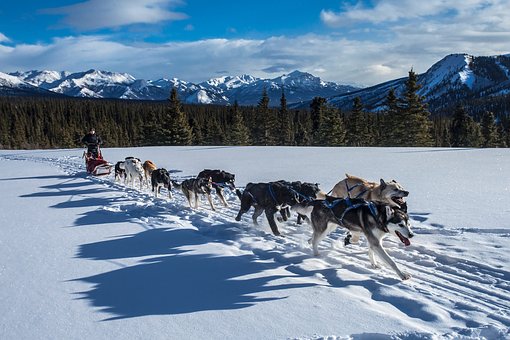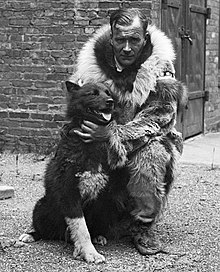Unlikely Heroes
In the 19th century, the sled dog was the primary means of transportation and communication in subarctic communities around the world.
Nowadays, Sled Dogs are mostly used in sporting events – although, in some areas, they still assist in transporting people and supplies in rugged, snowy terrain.
Breeds Used As Sled Dogs

Alaskan Malamutes – Because of their strength and endurance, they were originally bred for hauling heavy freight. They’re also referred to as Alaskan sled dogs.
Canadian Eskimo Dog – An Arctic breed of working dog that was born to pull. It’s not uncommon for them to go all day in harness.
Greenland Dog – A large breed of husky-type dog that is kept as a sled dog, and also used for hunting polar bear and seal.
Diphtheria!
Diphtheria is “a serious, contagious bacterial disease marked by high fever, weakness and the formation in the throat and other air passages of false membranes that cause difficulty in breathing.” (The American Heritage Dictionary) It also can result in “potentially fatal heart and nerve damage by a bacterial toxin in the blood. It is now rare in developed countries because of immunization.” (Oxford Dictionary)
In 1925, an outbreak of diphtheria threatened Nome, Alaska.
Almost 100 years ago, this deadly disease could easily have spread across the northern Alaska villages of which Nome was the hub. It would have greatly harmed the people.
Gunnar Kaasen
Gunnar Kaasen was born March 11, 1882, in Norway, the son of Hans and Anna Kaasen, in Burfjorddalen, in Troms county, Norway. When he was 21, he moved to the United States to find his fortune in the Gold Rushes that had occurred in Alaska in the late 1890s.
When that was over by 1905, Kaasen became a resident of Nome. Nome is located on Norton Sound. It is usually ice-locked for eight months every year, making it inaccessible by ship. In the 1900s, dog-sledding was a primary form of transportation – and a communication link to the outside world – so Gunnar learned to be an excellent musher.
What, you may be asking, is a “musher”? I did! A “musher” is a) the driver of a dogsled and/or b) a person who competes in cross-country races with a dog team and sled.
Balto
In 1919, Samuel Balto, a purebred Siberian Husky, was born in a kennel owned by Leonhard Seppala, and named in honor of Samuel Johannesen Balto, a Norwegian explorer and adventurer who died in 1921.
The Husky was Black with white “socks,” “bib,” and partial white markings on his belly and the tip of his muzzle, which advanced with age (including white markings around the eyes when he was old). His eyes were dark brown. (Wikipedia.org)
Balto was Gunnar’s lead dog. Gunnar was an employee of Seppala.
The freight dog that Seppala considered a second string, not very speedy racer became a canine hero that led his team on the final leg of the Great Race of Mercy.
The “Great Race of Mercy”
When the threatened diphtheria break-out occurred, there was no real way to get to Nome to provide an antitoxin. Little children would surely die without it.
Governor Scott Bone (AK) is probably best known for making the decision to use dog sleds for the transport of serum to fight the disease. He had no choice, really. The port was frozen, no trains went that far, and the only two planes had open cockpits (and they had never been flown in Winter).
So, Gov. Bone authorized transference of 300,000 units of serum from Anchorage to Nenana by train, and then the serum was picked up by more than 20 mushers, who faced a blizzard – -23°F temperatures and strong winds – to participate in this race to save lives in Nome.
It was reported in the news, all over the world.
This event was called the “Great Race of Mercy” and the “1925 Serum Run to Nome.”
Grueling Trip for Mushers and Dogs
5 and a half days! 674 miles. Treacherous weather and impossible terrain.
This was the most famous event in the history of mushing. Unfortunately, in later years, the first aircraft in the 30s, followed by the snowmobile in the 60s, practically drove dog sledding into extinction.
Balto and Gunnar

Gunnar and Balto were part of the group of mushers taking the serum from Anchorage to Nome. Kaasen’s team was one leg before the last of the relay, traveling from Bluff to Point Safety, Alaska, transporting a 20-pound cylinder of serum.
Kaasen drove his team of 13 dogs, led by Balto, mostly in the dark, over around 29 miles, through fierce winds that flipped the sled over, with visibility so poor he could not always see the dogs harnessed closest to the sled. Kaasen almost lost the cylinder containing the serum!
Almost There!
The team reached Port Safety ahead of schedule, at 2 AM, on February 2, where they were supposed to hand off the serum to Ed Rohn. Rohn was asleep when they got there, so Kaasen decided to just continue without awakening Rohn.
That meant they had to travel another 25 miles to get to Nome.
On Monday, February 2, 1925, at 5:30 AM, the Gunnar/Balto team arrived at Front Street, in Nome. It is said that on this freezing morning Gunnar staggered into Nome, his dogs cold and exhausted, their feet torn and bloody. After giving the cylinder of serum to Dr. Curtis Welch of the Public Health Service (the only physician in Nome), Gunnar began pulling the ice splinters out of his dogs’ feet.
They had travelled a total of 54.3 miles, arriving in the same spot where the Iditarod Trail Sled Dog Race (run to commemorate the Iditarod Trail and the serum run) ends each March.
No More Deaths
Within five days after Dr. Welch distributed the serum, the epidemic was halted. Thankfully, no further deaths were reported.
Five days after the original delivery, a second batch of the serum was transported from Seattle, WA.
Celebrities
Gunnar Kaasen and Balto made history that day, delivering the life-saving serum safely to Nome. Since they were the team that delivered the serum, they received the bulk of the press’ attention – photographers, film crews, etc. They got a tour of the States. And Balto and his team appeared in a movie (Balto’s Race to Nome (1925)). Balto became the most famous canine of the era – second only to Rin Tin Tin.
In addition to the daily stipend all the other mushers received, Kaasen was given a citation by the Governor of the Alaska Territory. He also received from the H. K. Mulford Company an award of $1,000. He was even offered a role in a movie.
Presented to President Coolidge
Received by President Calvin Coolidge and favored by the press, Kaasen was celebrated in a way the other mushers were not.
Many years later, Kaasen lived in Everett, WA, from 1952 to 1960. In 1960, he succumbed to cancer. He was 78. Kaasen was buried at Everett’s Cypress Lawn Memorial Park next to his wife, Anna.
Balto rested at the Cleveland Zoo until his death on March 14, 1933. He was 14. His remains were mounted by a taxidermist and donated to the Cleveland Museum of Natural History.

Pingback: March Happenings - WetNoseCentral
More of an “Unlikely Story”. Better still, checkout the movie: https://en.wikipedia.org/wiki/Togo_(film)